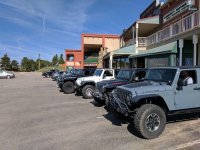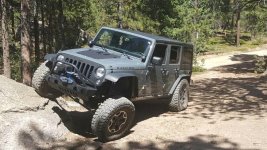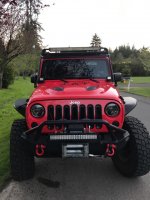suicideking
New member
I see a lot of Jeeps with a black vent on other base colors.
Anyone with a black Jeep with a different color PS vent?
Anyone with a black Jeep with a different color PS vent?
Disclaimer....I am not a scientist nor am I an expert in aero/thermo dynamics....this is just information I have read over the years.....
When it comes to modern cars (and I use the word cars to describe vehicles) they are built to withstand the extremes of ALL temps, since they are marketed all over the world and engineering them for specific regions would be too costly...so, they must work in the winter in Norway or the summer in Dubai, in traffic, with the AC running, with black paint. To achieve this, generally speaking, the engine bay is designed using a low pressure system, so when you are moving, cold air (aka ambient air) is forced into the engine bay through the front grill, towards the top of the engine bay, thus, pushing the hot air down, which is then sucked out from underneath under the vehicle as you drive along. I have seen tests done with vented hoods on sports cars, and at speed (unless they were engineered with serious money behind it) the vented hoods would actually disturb the low pressure system, causing more heat to be trapped under the hood.
Now, when we are talking about stationary or very slow movement (ie, running a trail or crawling) then you go back to the basics of hot air rising, and in that case, a vented hood will indeed help you.
Just thought I'd throw that out there.
I too am not an engineer by any means - but I think creating a plane of low pressure is the reason most of the vents in the PSC louver are (somewhat counterintuitively) facing backwards. The ridges that form the vent deflect airflow upwards, increasing its velocity. This increase in velocity creates a pocket of low pressure...which forms right above the opening. This is the same principle behind an airplane wing - the air deflected above the wing creates a lower pressure above the wing which helps keep the plane in the air. I think.
From one non engineer to another, it would seem that at speed, cold air entering the grill now has an escape route and goes out the top, rather than get trapped and push hot air down. Again, I don't have the formulas or the equipment to prove any of this, just applying amateur knowledge to a complicated subject.
Pretty sure anviljk has thatDoes anyone have pics of a PS hood louvre on an Anvil colored Jeep?
Sent from my iPhone using WAYALIFE mobile app
Pretty sure anviljk has that



I've got a smittybilt stingray hood (same style as 10a hood) and my eng temps have gone dow a fair bit. I've got the superchips trail dash and I noticed driving with my stick hood on in 90-100 degree weather that my temps would be around 220-230 now with this hood it's more like 210-220. View attachment 265446
Sent from my iPhone using WAYALIFE mobile app
I put the same hood on and cut out the back of the louvers. I really haven't seen any reduction in temps though. It looks cool so I like it.
Sent from my iPhone using WAYALIFE mobile app
I also cut the backs out of the Louvers but I did remove my front inner fender liners not sure how much that helped.
Sent from my iPhone using WAYALIFE mobile app
